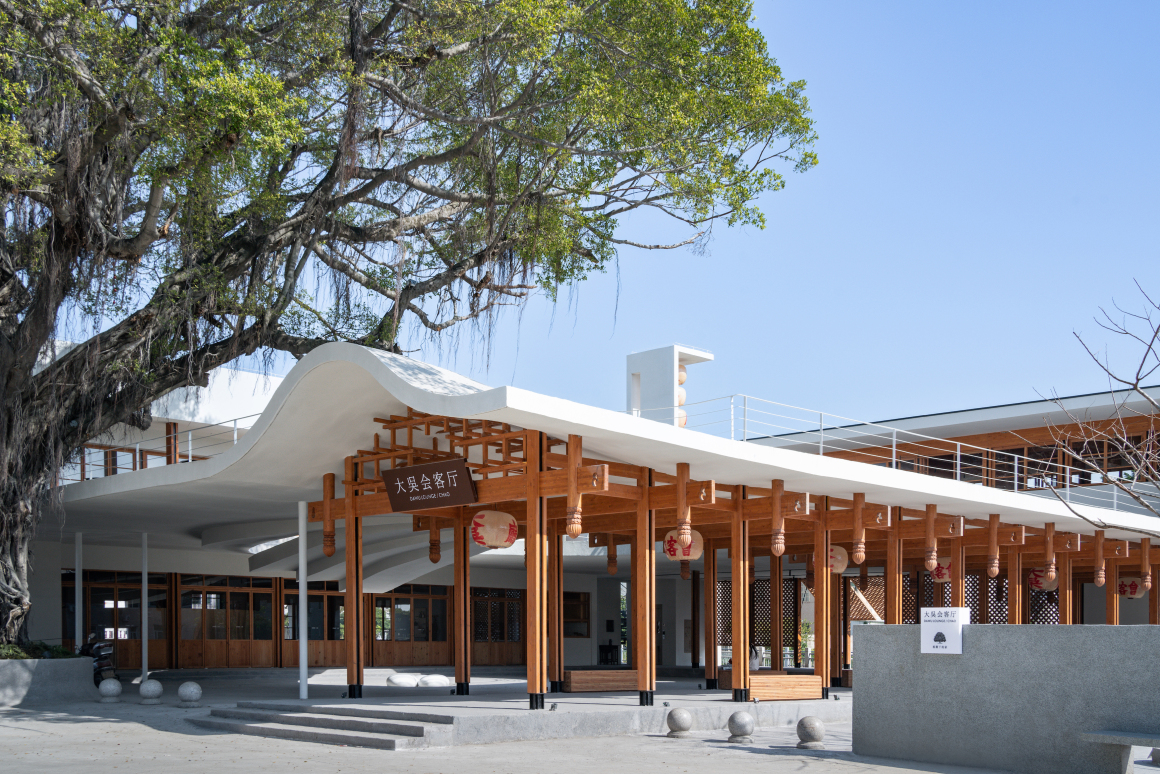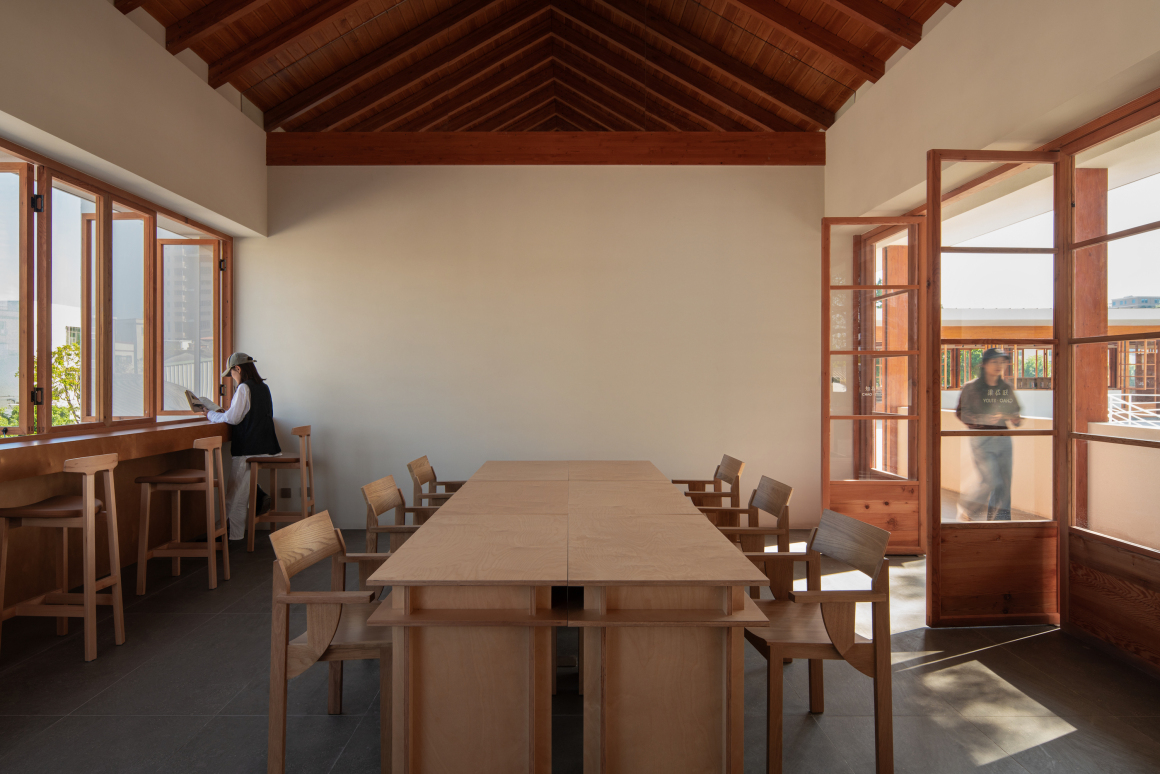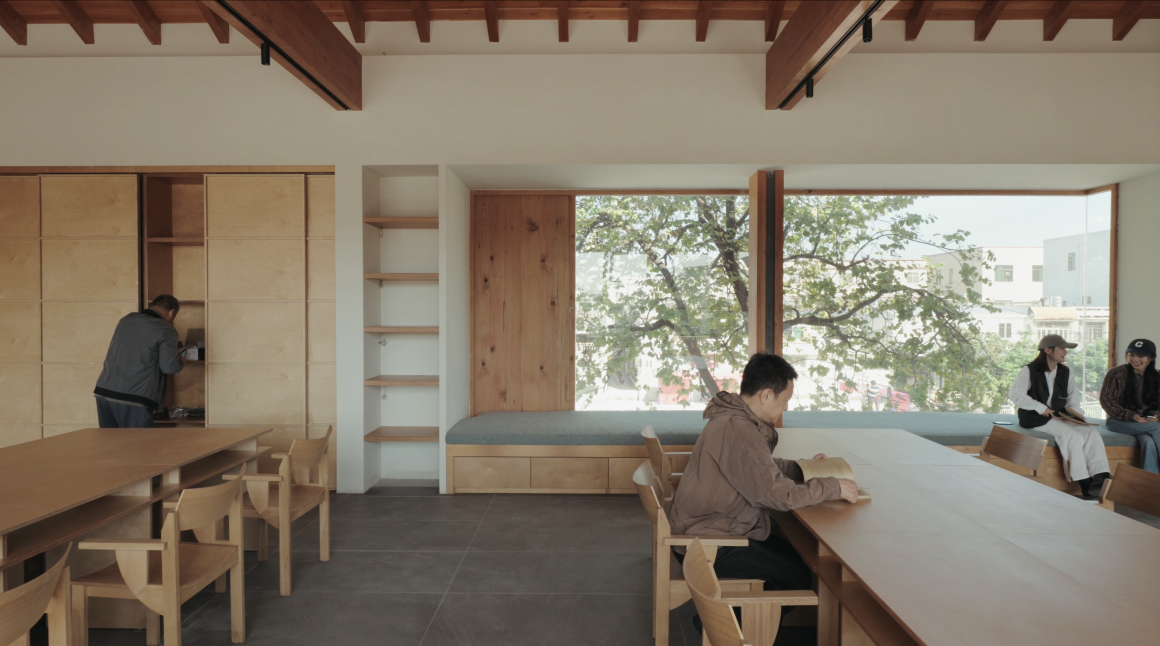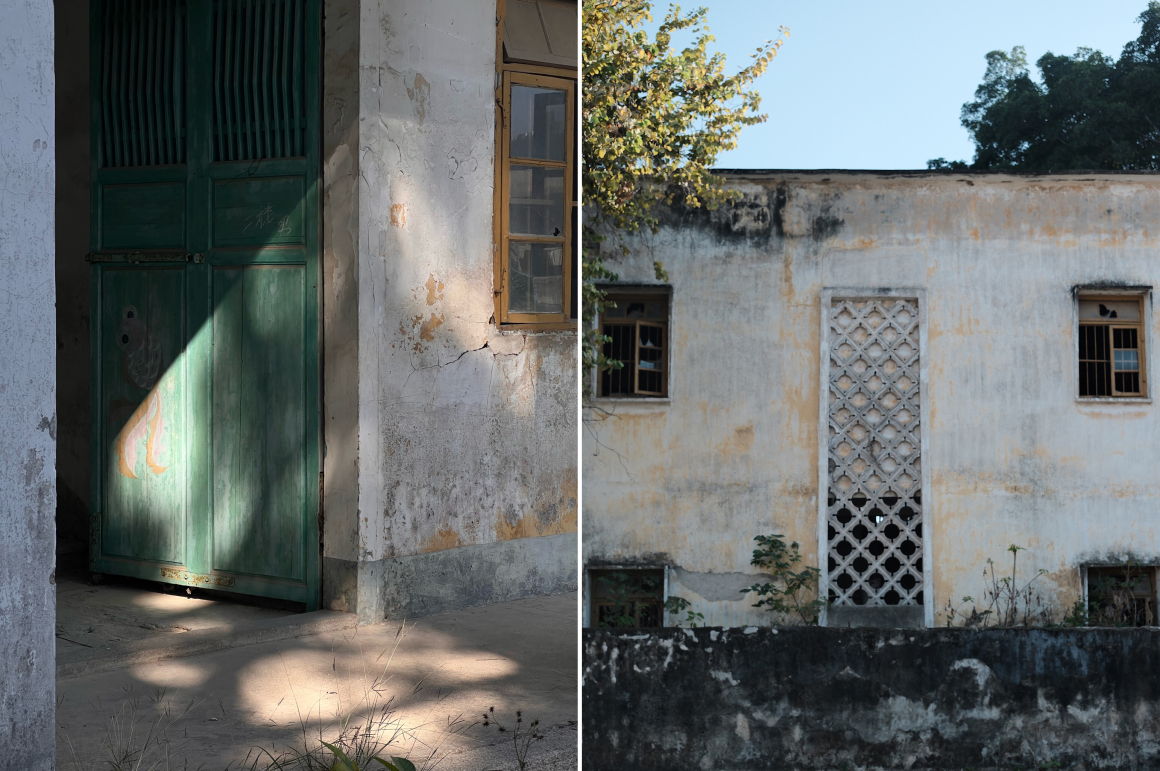本文由无设建筑授权mooool发表,欢迎转发,禁止以mooool编辑版本转载。
Thanks Not A Studio for authorizing the publication of the project on mooool, Text description provided by Not A Studio.
无设建筑:记忆中的幼儿园是懵懂、甜蜜且富足雀跃的。出现在建筑师顾忆面前的教学场景,是孤寂、 破败,到处是被时间遗忘的味道。
“我们想建造一片榕树下的树荫。它自治、开放、友好、 松弛;有多种功能的输出,让人随时都想进来,进来之后能呆得住。喝茶、聊天、看书、发呆、写作业、听潮戏、玩泥塑、吃流水席……”
Not A Studio: The kindergarten in architect Gu Yi‘s memory was naïve, yet sweet and prosperous, while the site during his first visit was lonely, dilapidated, as if it was forgotten by time.
Naturally, the architect would like to renovate the school into “a shade”, close and under the shelter of the banyan tree. The new building should be spontaneous, open, friendly, and relaxed; it will encompass multiple functions that enables visitors to come at any time and most importantly, to be willing to spend time afterwards. One could enjoy their quality time with friends or by oneself, drinking tea, like chatting, reading books, daydreaming, doing homework, listening to Chao Opera, playing clay sculptures, or having dinner parties……
▽被时间遗忘的幼儿园 ©无设建筑
▽项目视频©Y³ STUDIO
▽改造后的幼儿园自治、开放、友好、 松弛,成为了一座服务于全村居民的公共活动中心 ©Y³ STUDIO ©廖沁芳
潮来潮去的乡愁
无论走多远,这里永远是我的家
Tide brings home nostalgia
No matter how far one trvaels, this will always be home
在潮州,几乎每个村落里都能见到榕树。它们枝叶繁茂,长须垂挂,为当地的村民遮风挡雨。 岁月荏苒 ,久而久之便成为了乡邻聊天自然聚集的“会所”、孩童嬉戏的乐园 ,也成为了人们心底抹不掉的一片乡愁。
白墙灰砖,榕树下穿梭着各自忙碌的村民,还有永远独守在家中的老人。这是许多母亲口中潮州家乡的样子 ,也是立邦创始人吴清亮先生心中故乡的画像。
In Chaozhou, banyan trees with ush branches and leaves can be found in almost every village, providing shelter for the local villagers away from wind and rain and a natural gathering spot for neighbors, a playground for children, and an indelible nostalgia in a localer’s heart.
▽设计是历史的叠加,有源可溯 ©Y³ STUDIO©廖沁芳
建造于 1980 年代的松昌幼儿园,是吴清亮先生回国捐资建造的第一批基础设施。在往后,无论从办学还是建筑的安全等级考虑,幼儿园也无法被正常使用。于是,吴先生和他的家人便委托《梦想改造家》节目组,希望将废弃多年幼儿园改造成一座服务于全村居民的公共活动中心。
Many people picture their hometown associated with white walls and gray bricks, busy villagers, and elderly people in front of their home alone, the same as to Mr. Wu Qingliang, the founder of Nippon Paint who donated money to build The Songchang Kindergarten in 1980s upon his return to China. With regards to the safety of the building and stability of a school, the kindergarten has been disused for a long time. Hence, Mr. Wu and his family entrusted “Dream Home” to transform the abandoned kindergarten into a public center which serves the entire village residents.
▽时间将会延续,大榕树会陪伴新一代的人延展新的记忆 ©Y³ STUDIO ©廖沁芳
延续榕树下的树荫
继续庇护村民的日与夜
Extend the shade under the banyan tree
Provide shelters for the villagers every day and night
大吴会客厅的创意 ,便来自于榕树下的这片树荫。
原先的校舍是一个四面围合的院落。有两层的教学楼,一层教师的辅助用房,还有一棵三百的参天大榕树。整个校舍就被安放在这棵榕树底下。“我们是见到这棵榕树后 ,生起了个灵感。以往的村子,大家都是在树下聚集各种的活动。聊天、吃饭、喝茶、乘凉。这棵树,因此成为了村里社交的灵魂。所以我们这次改造的核心,就是要把这个院子全部打开,让整个空间看上去就像是一片巨大的树荫。”顾忆回忆起一年前的对于建筑改造最直接的灵感来源。
The design concept for Living Room of Dawu Village draws from shades of banyan trees.
The original site was a quadrangle courtyard with a two-story teaching building, a one-story building with auxiliary rooms for teachers on one side. The entire school building is placed under a tall banyan tree of 300 hundred year old. “After witnessing this banyan tree, we had an inspiration that people in the village liked to gather under the tree for various activities such as chatting, eating, drinking tea, and enjoying natural breeze. This tree has become the soul of social interaction for the village. Therefore, the core ideal of renovation is to open up the entire courtyard, simulating a huge shade of trees “, said by Gu Yi, when he recalled his direct inspiration of the design a year ago.
▽改造的核心,就是要把这个院子全部打开,让整个空间看上去就像是一片巨大的树荫 ©廖沁芳
空间以三百岁的大榕树为起点 ,向四周扩延。建筑设计团队拆除了重重的围墙,借助先进的钢木结构,来营建一个隔而不断的无边界社区。
The space starts from the 300 year old banyan tree and extends outwards by dismantling a few walls and regenerate in advanced steel and wood structures to build a borderless communal center.
▽设计拆除了重重的围墙,借助钢木结构营建一个隔而不断的无边界社区 ©廖沁芳 ©Y³ STUDIO
也是秉承这样的设计理念,建筑师把原先两层教学楼作了重新的梳理,将临河部分的公厕推翻,一并作了改造。将原先教师的辅助房全部打开,做成了连廊。在一层的平台延生出一片有趣的曲线连接至二层,构建了一座像看台一样的立体空间,释放出众人安坐于榕树下的观演体验。
Adhering to this design philosophy, the architect reorganized the original two-story teaching building by demolishing the public toilets near the river and the auxiliary rooms into corridors. An interesting curve extends from the platform on the first floor to connect with the second floor, creating a three-dimensional space resembling a bleacher, forming performing experience of people sitting under the banyan tree.
▽二层延展出一个户外的“灰空间” ©Y³ STUDIO
▽圆洞呈现了互通、对望与对话的关系 ©廖沁芳 ©Y³ STUDIO
新与旧的共生
体会时间的痕迹
A dialogue between old and new
A thought for the traces of time
大吴会客厅的另一番特写,是新和旧的元素在这里并存,并穿插于全新的结构与形式中。建筑师保留了历经 40 年风雨的“松昌教学楼”牌匾以及一面砖墙,砖墙上还留下孩子们涂鸦的画作与青绿色的一扇木门。潮州靠海。建造房屋的墙砖是将贝壳磨成的粉末混入泥沙,再压成砖块,是当地比较特别的建造工艺。在搭建全新的水洗石材质的门窗体系时,水洗石的研制也一并遵循了潮州的传统做法。同时,还保留了石碑、铭牌、木雕、石柱等老物件,期待它们在新建筑中依旧发挥重要的守护的力量。也想通过这种方式致敬潮州文化中“做人有前才有后,万事有交代”的传统礼制。
Another highlight feature for Living Room of Dawu Village is the coexistence of new and old elements, interspersed in a completely new structure and form. The architect has preserved the plaque of the “Songchang Teaching Building” that has weathered 40 years, as well as a brick wall with graffiti paintings by children and a green wooden door. Chaozhou is close by the sea, so the wall tiles are made by mixing powdered shells with sand and then pressed into bricks, which is a unique construction technique in the area. When building a new door and window system made of washed stone material, the development of the materials also followed local traditions. At the same time, old objects such as stone tablets, nameplates, wood carvings, and stone pillars have been preserved to punctuate the importance of protection and sustainability in the new architecture. By this method, the architect pays tribute to the traditional ritual system embedded in Chaozhou culture, which emphasizes the importance of cultural heritage.
▽石碑、铭牌、木雕、石柱,新和旧的元素在这里并存,并穿插于全新的结构与形式中 ©Y³ STUDIO
无论是一楼还是二楼,建筑师选用传统木质窗棂以及大量的木质家具作为室内的填充,因为这一类的手工艺赋予了许多现代材料所没有的温度,也体现潮州作为非遗文化传承城市,对手工艺与自然的珍视。
远远看着,这是一座重新崛起的新建筑。但当村民们走进来的时候,会在许多细节之处触摸并感知到时间流淌过的熟悉的痕迹。
Whether on the first or second floor, traditional wooden window frames and a large amount of wooden furniture has been introduced to create warm amibiance, and to reflect Chaozhou’s appreciation for craftsmanship and nature as a city that inherits intangible cultural heritage.
From a distance, this is a newly risen building. But when the villagers walk in, they will perceive the sense of familiarities through many details.
▽木构以及灯笼作为项目标识元素,是这座新建筑对历史的回望 ©Y³ STUDIO ©廖沁芳
让每一天的阳光
通过这片树荫慢慢渗入村民的日常
Let the suns shine every day
Let the “shade” seep into daily lives of the villagers gently
建造一片看似轻盈亦能承重的“树荫”并不容易。整个跨度近乎 20 米 ,却看不到一根立柱。王锦老师最终以22公分的尺度完成了这个挑战,成就了整个项目中一抹亮点。“这应该算是我做过难度系数最高的一个项目了。”王锦说。
一座被时间封锁的校舍,已经被建筑师顾忆的用心与巧思缓缓打开。大吴村的乡民又或者是慕名而来的客人正从四面八方走进这里。
Building a seemingly lightweight and load bearing ‘tree shade’ structure is not easy. The entire span is almost 20 meters without a single exposed pillar. Ultimately, the structure was completed with a scale of 22 centimeters, creating a highlight spot for the project. “This should be considered as the most difficult project I have ever worked on”, said Wang Jin from the structure team.
A school building that has been sealed off by time has been opened up and renewed ingenuine details by Gu Yi’s team. Villagers from Dawu or visitors who came here out of admiration are gathering here, a multi-functional architecture for everyone. The first floor ia planned in corridor, theater, handicraft workshop, and shared kitchen while the self-study room, tea house, and cultural heritage experiential room are placed on the second floor. Children study and play games here after school when parents could have tea here. The elderly spend time together while aunties who enjoy singing Chao Opera could rehearse and perform informal dramas. During festivals and holidays, everyone gathers here to worship ancestors, dance lions, sing Chao Opera, and have dinner party.
▽这座历史建筑重新被设计师重新打开 ©Y³ STUDIO
一楼的连廊、剧场、手作坊、共享厨房;二楼的 自习室、茶书院、非遗体验区。一幅幅被树影、水波纹浸透的画卷舒展开来:放学后的孩子们在这里自习、奔跑;家长们围坐在这里聊天、喝茶;老人家们三两依靠着打发时间;喜欢 唱潮剧的阿姨们,在这里排练,上演着并不正式的剧目。逢年过节,大家都聚拢在此处一起 祭祖、舞狮、唱英歌、大摆流水席。
榕树下的“大吴会客厅“,是属于大吴村里的会客厅。村民们在这里得以享受他们在家以外的所有的休闲活动。同时 ,也可以成为招待宾朋最具备仪式感的空间。
Living Room of Dawu Village under the banyan tree is served as the public center in the town. Villagers can enjoy all their leisure activities outside their homes here. At the same time, it can also become the most ceremonial space to treat and entertain guests.
▽人们重新回到这座被时间遗忘的校舍 ©Y³ STUDIO
▽大榕树下的“大吴会客厅“,终属于大吴村里的会客厅 ©Y³ STUDIO
建筑师顾忆希望这个公共空间是开放的,包容的、平和的。它不应该被定义,并且可以满足多样化的需求,适用于任何的场景。“你不用去刻意的看到设计的手法,你最终体会到的还是设计师的初心。”他希望这里能够伴随着徐徐吹来的风,让每一天的阳光,甚至是雨水慢慢地渗 入到村民的日常活动中来。希望他们能够爱这个地方,就像顾忆和他的小伙伴们,以及《梦想改造家》的团队们珍爱这棵大榕树一样。
Architect Gu Yi aspires to design this public space to be open, inclusive, and peaceful. The renovated building should not be defined and can meet diverse requirements, applicable to any scenario. “You don’t have to deliberately find any design techniques, what you ultimately experience is just an architect’s original intention.” This is a building for every village and indeed accommodate their daily activities, accompanied by breeze, sunshine even rain of every day. Just like Gu Yi and his friends, as well as the team of ‘Dream home’ cherish this big, old banyan tree, the new space could be adored by everyone.
▽历史建筑的印记 ©无设建筑
▽新的建筑材料尽量简单,但在精神上,我们不仅让潮州人看到了当代,同时也看到了当代里的历史 ©Y³ STUDIO
▽项目设计图©无设建筑
“ 这里,所有的地方都可以坐得下来,我们设置了非常多的可以坐下来的关系。材料尽量简单,但在精神上,我们不仅让潮州人看到了当代,同时也看到了当代里的历史。”
审稿编辑:junjun
更多 Read more about: 无设建筑















































0 Comments